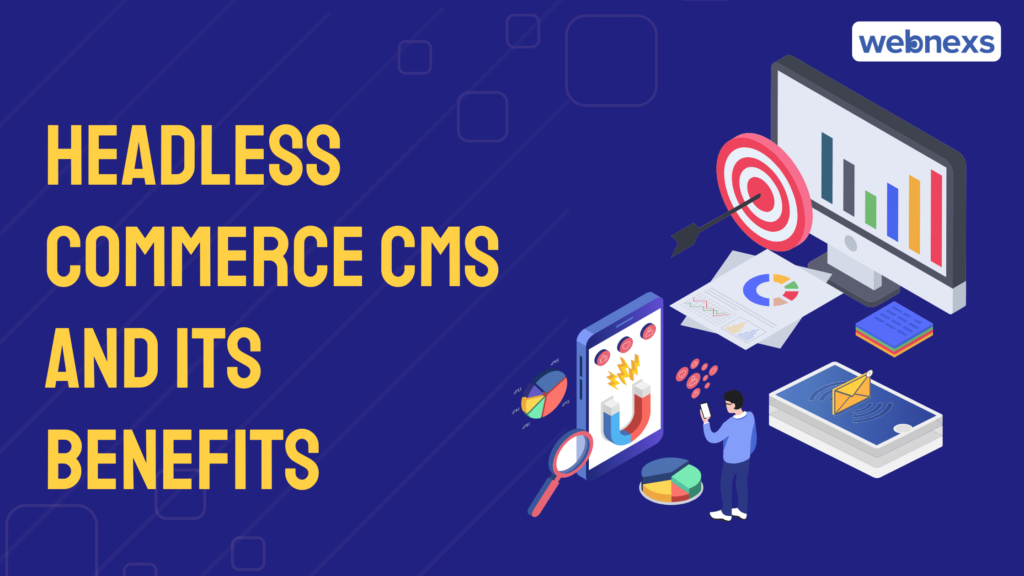35% of marketers reported an improved user experience after transitioning to a headless CMS.
Learn about the classic headless CMS platform’s benefits in building an ecommerce site. Here’s the best overview of headless CMS for you.
What is a Headless CMS?
Headless commerce CMS provides an API to deliver content across various platforms like websites, mobile apps, and IoT devices by supporting only back-end systems to manage and store content without a built-in front-end.
Decoupling the front-end and the back-end provides a greater level of flexibility, scalability, and customization to allow businesses to deliver consistent experiences while using any technology for the front end across multiple channels.
Headless CMS market is expected to reach USD 3.8 billion by 2032, growing at a CAGR of 22.6% from 2020 to 2027.
What Does the Headless CMS Platform Look Like?

Headless CMS tools are a new way of doing business in which the front-end is separate from the back-end, and headless commerce’s front-end uses a framework such as AngularJS or ReactJS.
Microservices architecture to build the back-end, which includes the ecommerce engine.The front-end and back-end of a traditional ecommerce setup are inextricably linked.
Any changes to the front end necessitate changes to the back end. The front-end and back-end are separate in a headless commerce setup. It enables the front-end to be developed separately from the back-end.
Headless commerce has many advantages over traditional ecommerce setups.
- For starters, it enables a more agile development process.
- Second, it makes scaling the front-end independent of the back-end easier.
- Third, it allows the use of different back-ends for different front-ends.
For example, you could use a headless commerce setup to create a mobile app with another back-end than your main ecommerce website.
Headless commerce is a new concept that is still evolving. As a result, there are no hard and fast rules for creating a headless commerce system. Conducting research to see what works best for your specific use case is the best way to learn.
71% of users report higher satisfaction with their content management and delivery speed after switching to a headless CMS.
Transform your ecommerce experience with this headless CMS. Join the 71% of users gaining faster content delivery and higher satisfaction.
Explore how a headless CMS can reinvent your business – Request Demo!
What Exactly is a Traditional CMS Platform?
A traditional commerce CMS is a content management system that allows business owners to create and manage an online store.
Traditional commerce CMS platforms typically include a shopping cart, order management, a product catalog, and payment processing to help businesses build and manage their ecommerce solution.
However, headless CMS systems offer a more flexible and scalable approach by decoupling the front-end and back-end, providing businesses with greater control over content delivery and user experience.
43% of businesses find that maintaining and updating traditional CMS platforms can be costly and time-consuming.
Headless CMS Systems: How Does it Work?
Headless commerce CMS is a back-end-only system that manages and delivers content to various front-end applications, such as a website, mobile app, or Internet of Things (IoT) device. These are considered to be the greatest headless CMS features to date.
The main benefit of using top headless CMS systems is that they allow for greater flexibility and agility in content management and delivery.
For example, they could be used to manage and deliver content to a website, mobile app, and IoT device, eliminating the need to duplicate content across multiple platforms.
56% of headless CMS users saw an improvement in their ability to manage content without needing to duplicate content.
Headless CMS and a Decoupled CMS: What is the Difference?
| Feature | Headless CMS | Decoupled CMS |
| Back-End and Front-End | Separates back-end from front-end | Separates back-end from front-end but allows multiple front-ends |
| Content Delivery | Delivers content to any device or platform via API calls | Delivers content to multiple front-end systems (website, mobile app, etc.) |
| Flexibility | High flexibility in displaying content across multiple front-ends | Less flexibility as it is optimized for a single front-end |
| Front-End Changes | Changes to front-end don’t affect the back-end | Changes to the front-end may require changes to the back-end |
| Content Management | Only handles back-end content management | Combines back-end content management with front-end display |
| Use Case | Ideal for displaying content on various platforms (website, mobile app, etc.) | Ideal for displaying content on a single platform, typically a website |
| Control Over Display | Provides more control over how content is displayed | Offers less control, with less flexibility in how content is displayed |
| Example Platforms | Suitable for platforms requiring multiple front-end access (e.g., API-driven platforms) | Suitable for websites or apps with integrated content management and display |
Headless CMS – 62% of companies report delivering content seamlessly across multiple devices via API calls.
Decoupled CMS – 45% of companies highlight its benefit in managing content for a single front-end and limited cross-platform flexibility.
Visit Here: Benefits Of Headless CMS And Growing Your Business
Top 5 Benefits of Using Headless CMS Platforms
There are many headless CMS features and benefits of the most popular, including:
1. Greater Flexibility
Flexibility is made possible using a headless CMS that works by decoupling the front-end and the back-end of the ecommerce platform.
This allows for using any programming language for the front-end that enables customization and innovation. The user interface can be tailored to the brand identity without being restricted to rigid templates of the traditional CMS platforms, showcasing the headless commerce advantages.
The flexibility extends to omnichannel content delivery, enabling seamless integration with websites, mobile apps, kiosks, and other devices through headless commerce.
Content can reach customers beyond physical boundaries while ensuring that a consistent experience is delivered across all channels.
This scalability ensures that businesses can maintain optimal performance while delivering seamless experiences to users across the globe.
62% of developers say that a headless CMS provides more flexibility in terms of front-end development.
2. Improved Performance
The optimization of content delivery is significantly enhanced using headless commerce systems, as they utilize caching mechanisms that store and serve pre-rendered HTML pages. This reduces the time it takes for customers’ pages to load, leading to improved site performance.
To minimize latency and ensure fast and reliable page loads, headless commerce advantages are leveraged when Headless CMS platforms integrate with CDNs to distribute content across servers located closer to end-users. For mobile users, this is essential as it enables the delivery of mobile-optimized content, ensuring better responsiveness.
The platform can remain stable and efficient without compromising on performance, even during heavy traffic. This results in an overall improved user experience, leading to higher engagement and conversion rates.
77% of businesses report improved website performance, citing faster load times and enhanced user experience.
3. Greater Scalability
For a growing business, a headless CMS is an excellent choice. Individual components can be scaled independently by utilizing a microservices architecture.
In addition to this, cloud infrastructure further enhances scalability with ease and enables businesses to expand their capacity without requiring hardware. High availability of content is ensured by deploying multiple servers worldwide, a key feature of headless CMS systems.
Sudden traffic or expansion into new markets can be handled with ease in a headless CMS architecture. This approach allows businesses to adapt quickly to market demands while ensuring a consistent user experience across all channels, showcasing the benefits of headless CMS systems.
62% of users report that they can scale individual components independently, reducing the risk of single-point failures
4. Tight Security
Security is ensured because the decoupled nature of a headless CMS limits direct interactions between the front-end and back-end.
A breach in the front-end cannot affect the back-end systems, thus enhancing the security of back-end servers. Additionally, delivering static content through CDNs reduces the risk of server-side attacks, further reinforcing the security in headless commerce setups.
Regular security updates from CMS platforms help keep systems resilient against emerging threats. For businesses handling sensitive customer data, this level of security is crucial for maintaining trust and regulatory compliance.
This robust security is one of the key benefits of headless CMS systems, offering peace of mind for businesses and customers alike.
71% of businesses claim that the decoupled architecture improves security by reducing attacks.
5. Improved Customer Experience
Highly personalized and seamless customer experiences can be delivered using headless CMS. Custom-designed front-ends can be offered to make them appealing and intuitive to users, directly reflecting the brand’s uniqueness.
Customization includes interactive elements, such as personalized recommendations and dynamic content that enhance user engagement. These are some of the key advantages of a headless CMS, allowing businesses to create unique and engaging experiences for their users.
Additionally, the decoupled nature allows for faster iterations and updates to ensure quick adaptability to customer needs and market trends.
Furthermore, it ensures a consistent experience across devices and platforms, offering headless ecommerce benefits by improving accessibility and usability for all users.
70% of users report a significant improvement in user engagement gained by delivering dynamic content and personalized recommendations.
Why Choose Headless Commerce CMS?
Headless CMS and Headless ecommerce platforms are prevalent today because they enable the creation of consistent, fast, and simple digital experiences.
A headless commerce CMS allows you to manage content for any digital experience, such as a website, mobile app, or voice assistant, offering key headless commerce advantages like flexibility and scalability.
By separating the front-end and back-end, businesses can build the front-end with any technology while the back-end is powered by a headless CMS or eCommerce platform.
This structure provides businesses with more flexibility, scalability, and the ability to create highly tailored digital experiences, offering the benefits of headless systems.
31.4% of companies reported that switching to a headless CMS saved them time in content and project management. Additionally, 61% of companies reported an increased ROI after migration to headless CMS according to a 2024 report.
Why Use Headless CMS Software?
There are numerous reasons why a headless is essential. One advantage of headless CMS is that you can decouple your commerce platform from your content management system.
It means you can use any content management system you want with your commerce platform, giving you more flexibility and options for managing your content.
Another reason why a headless CMS platform is essential is that it allows you to scale your business quickly.
A headless commerce CMS can provide an API for connecting to other headless systems, making it easier to expand your enterprise into new markets or add new products and services.
Finally, a headless commerce CMS can assist you in providing your customers with a more personalized shopping experience.
You can gain more control over the customer experience by using the benefits of headless architecture to create a single customer profile that can be used across all your channels.
56% report increased customer engagement and loyalty, while 60% have seen revenue growth.
Click Here: How Does Headless Ecommerce Help To Succeed In Business?
Conclusion
Headless CMS platforms offer numerous benefits, but you can take it a step further by leveraging a headless commerce solution.
Instead of relying on traditional eCommerce websites or applications, you can use your website to directly manage product catalogs, process orders, and drive sales.
With an enterprise-level headless CMS, you can efficiently manage your content while seamlessly integrating sales and order processing directly through your website.
This approach eliminates the need for conventional ecommerce platforms, streamlining operations and enhancing overall performance.
With the significant acceleration of the adoption rates, make your business count among them and experience the benefits of this transformation.

